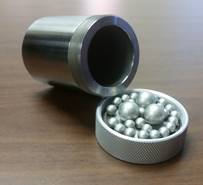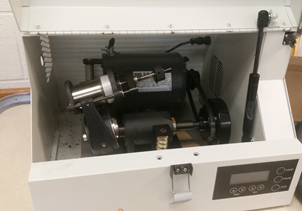Ligas Nanocristalinas e Estabilidade de Tamanho de Nano-grão
Visão Geral
Fonte: Sina Shahbazmohamadi e Peiman Shahbeigi-Roodposhti-Roodposhti, Escola de Engenharia, Universidade de Connecticut, Storrs, CT
As alusões com tamanho de grão inferior a 100 nm são conhecidas como ligados nanocristalinas. Devido às suas propriedades físicas e mecânicas aprimoradas, há uma demanda cada vez maior para empregá-los em várias indústrias, como semicondutores, biosensores e aeroespaciais.
Para melhorar o processamento e a aplicação de ligas nanocristalinos, é necessário desenvolver materiais a granel cerca de 100% densos que exigem um efeito sinérgico de temperatura e pressão elevadas. Ao aumentar a temperatura e a pressão aplicadas, pequenos grãos começam a crescer e perdem suas propriedades distintas. Assim, é tecnologicamente importante chegar a um compromisso entre a ligação entre partículas com a mínima porosidade e perda de tamanho de grãos nanoescala durante a consolidação a temperaturas elevadas.
Neste estudo, pretendemos eliminar o oxigênio da solução sólida para melhorar a estabilidade do tamanho dos nano-grãos a temperaturas elevadas. A linha de luz Fe-14Cr-4Hf nano cristalina será sintetizada em um ambiente protegido para evitar a formação de partículas de óxido.
Procedimento
- Arquive os materiais a granel de baixo teor de oxigênio de alta pureza (alvos Fe, Cr e Hf) no porta-luvas usando uma máquina de arquivamento mecânico recíproca, a fim de minimizar a contaminação de oxigênio nos pós de partida.
- Carregue a mistura em pó para uma liga específica (Fe14Cr4Hf wt.% neste estudo) em um frasco de aço inoxidável junto com bolas de fresar aço inoxidável 440C(Fig. 1). Os diâmetros das bolas de fresagem são de 6,4 e 7,9 mm e a relação pó-peso da bola é de 10:1. O frasco selado precisa ser
Resultados
Fig. 3 mostra os dados XRD para of-Fe14Cr4Hf a uma hora a 900°C. Há afiação dos picos junto com pequenas mudanças de pico. É devido ao relaxamento da tensão da rede à medida que a temperatura aumenta. Quando a temperatura aumenta, vários pequenos picos são revelados entre os quatro principais picos do BCC. Isso indicaria a formação de fases secundárias.
Fig. 4a-c mostra imagens TEM e padrão de difração para OF-Fe14Cr4Hf enraizado por 1 hora a 900°C. Partículas nano...
Aplicação e Resumo
O experimento demonstra como a estabilidade do tamanho de nano-grãos dos materiais nanocristalinos nominalmente livres de oxigênio pode melhorar a comparação com as alusões com quantidade significativa de oxigênio. Neste estudo, os pós de OF sintetizados em uma atmosfera protegida para minimizar a interação entre oxigênio e solução sólida leva a aumentar a segregação de elementos de a totalidade para os limites dos grãos e melhorar a estabilidade do tamanho do grão termodinâmico. O microscópio TEM intr...
Tags
Pular para...
Vídeos desta coleção:

Now Playing
Ligas Nanocristalinas e Estabilidade de Tamanho de Nano-grão
Materials Engineering
5.1K Visualizações

Materialografia Óptica Parte 1: Preparação da Amostra
Materials Engineering
15.4K Visualizações

Materialografia Óptica Parte 2: Análise de Imagens
Materials Engineering
11.0K Visualizações

Espectroscopia de fotoelétrons de raios-X
Materials Engineering
21.6K Visualizações

Difração de raios X
Materials Engineering
88.9K Visualizações

Feixes de Íons Focalizados
Materials Engineering
8.8K Visualizações

Solidificação Direcional e Estabilização de Fase
Materials Engineering
6.5K Visualizações

Calorimetria exploratória diferencial
Materials Engineering
37.4K Visualizações

Difusividade Térmica e Método do Flash de Laser
Materials Engineering
13.2K Visualizações

Galvanoplastia de filmes finos
Materials Engineering
20.0K Visualizações

Análise da Expansão Térmica via Dilatometria
Materials Engineering
15.7K Visualizações

Espectroscopia de Impedância Eletroquímica
Materials Engineering
23.2K Visualizações

Materiais Compósitos de Matriz Cerâmica e Suas Propriedades de Flexão
Materials Engineering
8.1K Visualizações

Síntese de hidrogéis
Materials Engineering
23.7K Visualizações
Copyright © 2025 MyJoVE Corporation. Todos os direitos reservados

